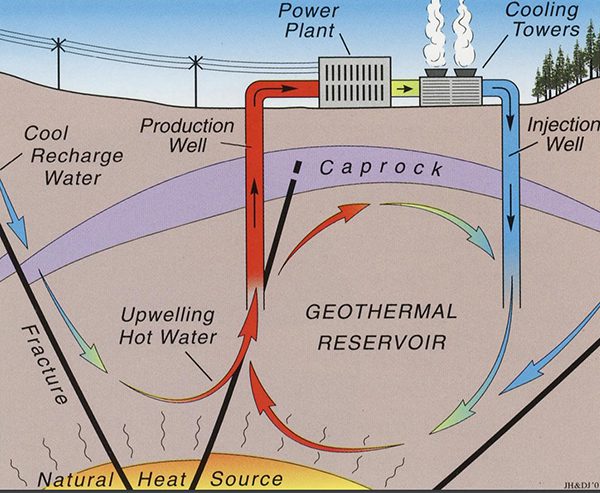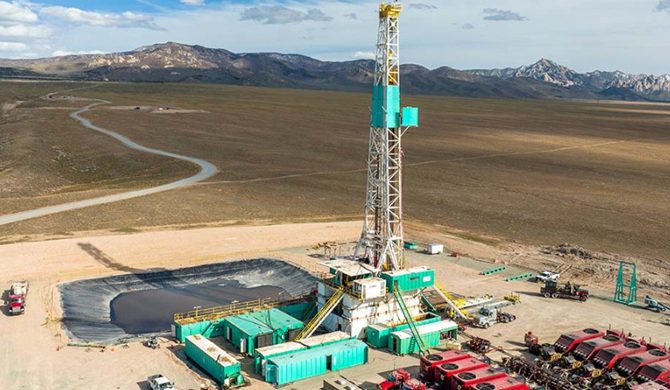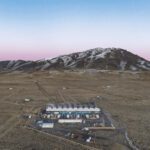The Department of Energy’s (DOE)’s latest Energy Earthshot will seek to cut the cost of enhanced geothermal systems (EGS) to $45/MWh by 2035, an ambitious goal that would shave current EGS costs by 90%.
The DOE’s latest Energy Earthshot—part of a 2021-research, development, and demonstration (RD&D) initiative it launched to accelerate breakthroughs for emerging technologies—will seek to “unlock the Earth’s nearly inexhaustible heat resources to provide reliable, clean power to American communities and expand opportunities for a robust domestic geothermal industry,” the agency said on Sept. 6.
The EGS Energy Earthshot is the fourth integrated program unveiled by the DOE over the past year. The agency unveiled its first Earthshot, the Hydrogen Shot in June 2021, seeking to reduce the cost of clean hydrogen by 80% to $1 per 1 kilogram within 10 years. The second Earthshot, launched on July 2021, is the Long Duration Storage Shot. It aims to reduce the cost of grid-scale energy storage by 90% for systems that deliver 10 hours or more of duration within a decade. The third Earthshot—the Carbon Negative Shot—was announced in November 2021, and it calls for technologies and approaches that will remove CO2 from the atmosphere and durably store it at meaningful scales for less than $100/net metric ton of CO2-equivalent (CO2e). As with other Earthshots, the agency said it plans to leverage department-wide efforts and engage with stakeholders across government and industry to achieve its targets for the EGS Energy Earthshot.
EGS: On the Cusp of Commercialization in the U.S.
EGS are advanced engineered geothermal reservoirs that involve drilling deep wells underground in hot rock at temperatures of 175C to more than 300C, but where there is little to no natural permeability or fluid saturation. “During EGS development, subsurface permeability is enhanced via safe, well-engineered stimulation processes that re-open preexisting fractures, create new ones or a combination of both,” the DOE’s Geothermal Technologies Office (GTO) says. “These open conduits increase permeability and allow fluid to circulate throughout the hot rock. The fluid transports the otherwise stranded heat to the surface where clean, renewable electricity can be generated with current power generation technologies.”

“The Earth is a huge thermal battery with vast geothermal resources and heat that is continuously generated by decay of radioactive elements,” explained Stuart Simmons, a research professor at the University of Utah’s EGI. The hottest geothermal resources—120C to 330C—are typically used to generate power from the production of hot water and/or steam from deep production wells, whereas cooler resources, below 150C, are used for a wide range of direct use applications, including district heating and cooling, he said.
But while geothermal resources naturally occur everywhere on Earth, harvesting them cost-effectively has been a challenge, owing to variability in rock temperature, permeability, and other conditions. EGS, which relies on man-made reservoirs drilled to depths of 3 to 10 kilometers, promises to change that.
The DOE on Thursday said that 5 TW of underground heat resources exist in the U.S. alone. The Western U.S. alone has a potential 518 GW of EGS resources—about half of the current installed electric power generating capacity in the U.S.—suggests the U.S. Geological Survey. GTO’s 2019 GeoVision report, however, concludes that with technology improvements, especially in areas relevant to EGS, geothermal power generation could increase 26-fold from today, representing 60 GWe by 2050, the majority of which would come from deep-EGS resources after 2030. GTO envisions that with focused technology advancements, EGS could make up 3.7% of total U.S. installed capacity in 2050, and 8.5% of all U.S. electricity generation.
But though EGS has been explored since the 1970s, efforts to develop EGS have remained small in scale, mainly owing to insufficient reservoir volume, difficulty with drilling, and induced seismicity. Since the first EGS pilot installation at Fenton Hill in the U.S. (which ran from 1974 to 1995), experimental projects have operated at Rosemanowes in the UK; Basel in Switzerland (which, at 3 MW, has so far been the largest in the world); Pohang in South Korea; Hijiori and Ogachi in Japan; and the Habanero project in Australia. Only a few EGS projects are currently operating: the 1.7-MW Soultz-sous Forêts in France; a 1-MW installation in Groß Schönebeck in Germany, and the 27.5-MWth Rittershoffen Geothermal Heat plant in the French Upper Rhine Graben.
FORGE: DOE’s Underground EGS Laboratory
For its part, the DOE has been exploring EGS since 2015 at the Utah Frontier Observatory for Research in Geothermal Energy (FORGE), its dedicated underground field laboratory situated near the town of Milford on the western flank of the Mineral Mountains. FORGE in April marked a significant milestone with the successful completion of its first large-scale 10-day stimulation in a deep-deviated well. (Read POWER’s in-depth story here: “Large-Scale Enhanced Geothermal System Trial Successfully Completed.”)
The successful stimulation trial demonstrated the “ability to initiate, propagate and ideally control hydraulic fracture growth,” the FORGE team said. That is crucial for “realistically evaluating the potential for commercial EGS applications,” it said. “Success here is important for promoting technical and hybrid EGS methods that use hydraulic injection to provide a heat exchange network or to achieve more effective connections with potentially productive natural fractures,” it said.
FORGE has in recent years opened up the site to public development. On Aug. 15, it solicited up to 17 awards and $44 million in funding for projects that could build on the site’s existing EGS work and “focus on reproducible solutions and dissemination of technical data.” The solicitation covers five topic areas: seismicity monitoring protocols, novel reservoir stimulation techniques, experiments on EGS heat extraction efficiency, materials to sustain flow pathways in EGS reservoirs, and tools that can withstand high temperatures while isolating zones within the wellbore.

EGS Energy Earthshot Will Address Technical, Economic Challenges
The DOE’s Energy Earthshot, meanwhile, will tackle technical and economic challenges that have so far posed significant hurdles for widespread EGS development. “The first technical barrier to EGS, as well as currently-existing conventional geothermal energy, is simply visibility: geothermal is a ‘hidden’ resource,” the DOE said. Advancements in sensor technologies and high-performance computing could help provide more visibility in EGS reservoirs, which can be as deep as 2 miles or more. Another technical barrier relates to EGS’s hard-rock environments. Along with requiring specialized drilling equipment, these environments can be corrosive. “Advances in the development of new resistant materials are beginning to overcome these challenges,” the DOE said. “With technology improvements, though, EGS could be engineered cost-effectively wherever there is hot rock at accessible depths, enabling economic capture of EGS potential nationwide.”
The DOE on Thursday, however, also highlighted several recent breakthroughs that “place EGS on the cusp of commercialization” in the U.S. Over the last decade, transformational advances in 3-D modeling have changed the design processes of projects, drill wells, and reservoirs. Technology and workflow advances adapted from oil and gas have also expanded the industry’s ability to precisely direct fluid flow below ground, it said.
“EGS is in the same technological place today that shale gas was twenty years ago—theoretically robust, practically feasible, but so far-unproven,” the agency said. “Over the last two decades, trial-and-error improvements on over 500 wells took shale gas technology from theoretical to exceedingly profitable. To date, less than 20 EGS demonstrations have been tried, but with this Energy Earthshot, we intend to drive a large increase in the number of EGS deployments, and in doing so, realize similar dramatic advances in cost and performance.”
The DOE also pointed to private-sector interest and development that suggest U.S. EGS commercialization may be close. Several projects have already leveraged federally funding to successfully implement working projects. One project, spearheaded by geothermal company Ormat Technologies, involved the stimulation of a non-commercial well on the periphery of its operating conventional geothermal system at Desert Peak, Nevada. The project, which set out to improve the permeability enough to connect the well to the existing geothermal power plant, was successfully concluded in 2013. “Following the successful result of a 1.7MW increase at Desert Peak, a permanent pipeline was built to Desert Peak 27-15 and has been in use since project completion,” the DOE said.
At another federally funded EGS demonstration, Calpine in 2012 reopened and deepened two wells—an injection and production well—that were drilled in the 1980s and abandoned in 1999 in the northwest Geysers. The area had been difficult to develop and produce due to high concentrations of noncondensible and corrosive gases, Calpine has noted. “The steam contributed by the two production wells within the EGS produce an additional ~5.8 MW of power,” the DOE said on Thursday.
Buoyed by recent developments, investment in hot rock development also appears to be picking up. Geothermal startup Fervo Energy, a company that is participating in FORGE, on Aug. 22 announced it raised $138 million to build, own, and operate power plants that will source energy from hot rock reservoirs. “The new funding helps Fervo complete power plants in both Nevada and Utah and evaluate new projects in California, Idaho, Oregon, Colorado, New Mexico, and internationally,” the company said last week.
The DOE said Earthshot will leverage several notable funding initiatives to further EGS advancement. In July, GTO announced $165 million for the creation of a consortium that will develop a roadmap to address technology and knowledge gaps in geothermal energy, based on best practices used within the oil and gas industry. The DOE said it would then use the roadmap to designate up to $155 million for research to address those gaps.
The Earthshot, whose primary concern is to realize dramatic cost reductions, could also be critical in the build-out of EGS pilot demonstration projects, for which the November 2021–enacted Infrastructure Act designates $84 million. The DOE in April issued a request for information to kickstart demonstration development. The legislation, notably, authorizes the DOE’s GTO to support four “competitively selected” pilot projects that demonstrate EGS in different types of geology and using a variety of development techniques and well orientations.
—Sonal Patel is a POWER senior associate editor (@sonalcpatel, @POWERmagazine).










